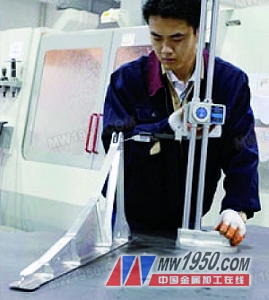The fierce competitive pressures in the international market have forced aerospace manufacturers to process parts more efficiently. Coupled with the emergence of advanced tools, high-end machine tools and advanced CNC systems, high-speed machining (HSM) technology is widely used in the aerospace industry. Started to be used only for processing aluminum alloy parts. After research and development, the newly developed HSM technology has been used for high-efficiency processing of new designs made of high-strength, light-weight titanium alloys, composite materials and other difficult-to-machine materials, including thin-walled Large aerospace high-precision product parts with extremely complicated shapes, including parts, have achieved good processing results (see attached figure). For a long time, HSM has been considered by many to be a less scientific term. According to Wayne Reilly, Haas Automation's application manager, when some people define HSM as a spindle speed of more than 10 000 Next page Internal Thread Cylindrical Pin,Alloy Steel Cylindrical Pin,Flat Head Cylindrical Pins,Polished Steel Cylindrical Pins Qingdao Yukun Bearing Needle Roller Co.,Ltd. , https://www.ykneedleroller.com
Processing thin-walled aerospace parts with high-speed machining technology
When r/min is processed, others think it is actually a more complicated definition. “We really need a more detailed interpretation of the term,†he said. “A tool manufacturer may pass the spindle of the machine. The speed is defined by HSM; the machine tool builder believes that the HSM should be defined according to the functions of the CNC system, such as the feedforward function of the CNC system, that is, the number of advance preview processing programs. Some people think that the cutting speed and feed rate should be considered at the same time. The cutting parameters such as the amount of backing knife are defined by HSM. We select the motor with a power of 22.4 kW in the machining, so that the cutting with the highest spindle speed of 30 000r/min is defined as high-speed machining, which will be used in machining. The VMC is defined as a high speed machining machine."
“I can't just consider the spindle speed of a machine tool. I like to talk about the new concept of high-efficiency machining,†said Von Moll, manager of aluminum product processing at MAG Cincinnati. He gives definitions of high-efficiency machining, including both dynamic response and spindle speed. The five main parameters of the high-efficiency machine he described are: 1 high spindle speed (r/min). 2 large spindle power. 3 High feed speed (including high feed speed and no-load fast moving speed along the tool path). 4 high plus / deceleration. 5 high processing accuracy. The latter three parameters are related to the dynamic response of the machine tool. The first two items are related to the cutting speed. “When high-efficiency machining of aerospace materials, such as aluminum alloy parts, what is most needed is the organic combination of high dynamic response and high cutting speed,†says Von Moll.
Some people have divided the aviation parts into two categories: "thick board" and "thin board". For example, Von Moll will select a maximum spindle speed of 18 000r/min, a spindle power of 100kW, a part thickness greater than 50mm, and a choice of a maximum spindle speed of 30 000 r/min, a spindle power of 60 kW, and a machining part thickness of less than 50 mm. They are all defined as high efficiency machining.
“The high dynamic response has a different impact on the overall high-efficiency cutting process for 'thin plate' and 'thick plate' parts,†explains Von Moll. “For example, when the machine's acceleration/deceleration is 0.5g, You should provide a feed speed of 38m/min as much as possible." The increase/deceleration speed of the machine tool greatly affects the machining time when the tool needs to frequently change the shape of complex parts, such as the cavity of a small mold. .
Because the fast feed rate processing and the fast moving speed of the no-load are close to the parts, the processing time is greatly affected, especially the "auxiliary time" is greatly reduced, so that the entire production cycle can be generally reduced when processing aluminum alloy materials. 20%. The “Auxiliary Time†also includes the clamping position of the new part and the exchange time of the tool. “In lean manufacturing terms, it is a useless time consuming that should be eliminated. To achieve fast feed rates at high acceleration/deceleration, a few years ago, MAG Cincinnati developed the HyperMach vertical copy milling machine series. Its main feature is the fast feed rate of up to 101m/min, which at the time was able to greatly reduce the "feed time" of the highest feed rate," Von Moll said. MAG Cincinnati is proud of the fact that the HyperMach vertical copy milling machine designs three-axis rotations of A, B and C in addition to the X, Y and Z axes. Among them, the X-axis has a working stroke of 33m, the Y-axis is 3500mm, the Z-axis is 1250mm, and the maximum spindle speed is 30 000 r/min. The biggest feature in the structural design of the machine tool is the assembly of a pair of independent work spindles on the X-axis bridge beam. “The machine tool can provide users with the processing capability of processing large parts of 2000mm×4000mm. After the IMTS 2008 exhibition, it is very popular among aircraft manufacturers.†According to Von Moll.